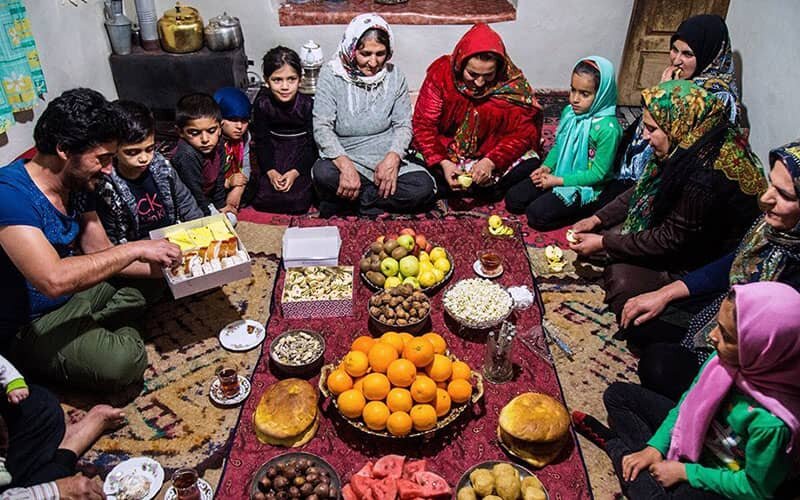Persian Yalda night gains place on World Cultural Heritage list

TEHRAN – Yalda night (Shab-e Chelleh), one of the most celebrated Persian traditional events which marks the longest night of the year, made it onto the United Nation's cultural heritage list on Wednesday.
Yalda/Chella was added as the new inscription on UNESCO’s list of intangible cultural heritage jointly for Iran and Afghanistan, adding another chapter in the age-old friendship between two ancient neighboring civilizations.
The decision was taken in the Moroccan capital of Rabat on Wednesday where the 17th session of the Intangible Cultural Heritage Committee of the United Nations Educational, Scientific and Cultural Organization (UNESCO) was held.
According to the UN cultural body, the ancient feast refers to a traditional celebration of the sun and the warmth of life. Practiced in Iran and Afghanistan, the event takes place on the last night of autumn, when families gather at the houses of elders and sit around a table adorned with a series of symbolic objects and foods: a lamp to symbolize light, water to represent cleanliness, and red fruits such as pomegranates, watermelons, beetroots, jujube and grapes to symbolize warmth.
Broth, sweets, dried fruits and nuts that are used specifically for the occasion are also set on the table and consumed during the gathering. Activities range from reciting poetry and storytelling to playing games and music and giving gifts to new in-laws, brides and children. The event celebrates cultural identity, nature, respect for women, friendship, hospitality, cultural diversity and peaceful coexistence. It is transmitted informally within families, although radio and television programs, publications, social media and educational materials have also played an important role in transmitting the practice in recent years. Events, conferences, trainings, workshops and awareness-raising activities carried out by research centers, NGOs, cultural organizations and educational institutes have also had a significant impact on the proper transmission of the element to future generations.
On that graceful night the winter chill is vanquished and the warmth of love embraces the entire family. It’s a time for pleasant family reunions that entails laughter, merriment and good cheer. Hearts move closer to one another in the company of loved ones on Yalda.
The last evening of autumn and the beginning of winter is a ceremonious, auspicious time for Iranians and lovers of Iranian traditions everywhere on earth. Though it is not even an official holiday, Yalda still stands head and shoulders above some other ancient traditions. By the way, television and radio programs fully cater to it by airing special programs. The reason is that it revolves around the rich, genuine Persian traditions. That’s why families are still eager to seize the moment and become fully engaged, putting their cell phones and other distractions aside.
Of all the ancient Persian festivals, only two are celebrated by Iranians worldwide -- Yalda Night (the birth of a new sun) and Noruz or Persian New Year (the birth of a new day). Nationally called “Shab-e Yalda” or “Shab-e-Chelleh”, it literally means the night of the forty. This refers to the first forty days of winter that are often the coldest and toughest to bear.
The story of Yalda may perhaps be interpreted as a tale of courage and effort during darkness, a triumph of light and human warmth that ultimately causes the spring to bloom in hearts.
People on Yalda Night are usually served with fresh fruits and colorful Ajil (a mixture of dry fruits, seeds and nuts) in floral bowls. To Iranians, fruits are reminders of abundance in summer. Watermelon and pomegranates, as symbols of bounty, are the traditional fresh fruits of this night. It is believed that eating watermelon before the arrival of winter can immunize the body against illness.
Following a hot dinner, many people often recite poetry, narrate stories, chant, play musical instruments or just chat cozily until midnight or so.
Facts to know
- Yalda Night is celebrated on the last day of Azar (the last month of autumn in the Iranian calendar year) and before the first day of Dey (the first month of winter).
- Watermelon and pomegranate are amongst the most characteristic features of Yalda Night so that a few days prior to Yalda, their prices usually soar.
- Yalda, though not very common, is a female Persian name.
- In the ancient Iranian calendar, winter is divided into two parts, Chelleh Bozorg (literary meaning the bigger forty) from 22nd of December to 30th of January and Chelleh Koochak (the smaller forty), which starts from 30th January to 10th of March.
- The word Yalda, meaning birth, was imported from Syriac into the Persian language by the Syriac Christians.
- Narratives say that Yalda Night marks the birth of winter and the eventual triumph of the sun as the days grow longer.
- Ancient Iranians assumed Naneh Sarma begins to descend on earth by Yalda Night. Literally meaning “coldness grandma”, Naneh Sarma is a folklore character who brings in the cold of winter but also the promises of spring ahead.
AM
Leave a Comment